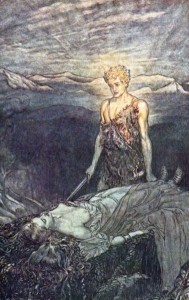
Due to the fact that recently I have spent a considerable amount of time driving, I decided that there could be no better opportunity to revisit the Ring Cycle. I was fortunate enough to see it staged last June at the Vienna State Opera and while there were some serious deficiencies in the production — such as the Brünnhilde — I found the experience of seeing the entire work again to be engaging, albeit tiring. Vienna’s Ring Cycle circa 2003 used to be presented in a most civilized manner: after a mid-week performance of Rheingold, the lengthier operas were held for Sundays starting in the late afternoon, allowing for sufficient time to enjoy a fortifying goulash prior to the experience (not unlike the American National Football League’s once-per-week schedule). This time around, they decided to go for a more intense schedule, presenting all four operas within the space of a week. I think I prefer the leisurely approach: in the week version, I felt as through I was running some kind of opera marathon, not once but three times. After seeing the entire cycle, I decided that it would be the ideal time to cement the operas into my musical memory by listening to them whenever possible. Pairing many hours in the car with the Ring Cycle was an ideal combination.
What has struck me in my most recent exploration of these works is their reliance on moments, a characteristic that I associate more with Italian operas rather than German ones. Virtually all of us are acquainted with these events in Italian works: consider the dramatic moments as Canio puts on his costume in Pagliacci, Cavaradossi recalls a rendez-vous under the stars, or Aida conjures up distant Ethiopia. In contrast, Wagnerian music drama is rarely discussed in such terms. Instead, there is a fixation on motives, particularly those that can be traced throughout the work and serve as clear signifiers of objects.
Yet Wagner’s works are equally dependent on moments to make them work. There is one key difference between a Wagnerian moment and an Italian one: Wagner relies less on the singer and considerably more on the orchestra. Moments are by no means unique to the Ring Cycle. Consider the return of Isolde in Act III of Tristan und Isolde: as she enters, we hear the same music that was played when the potion took its effect in the first act. However, this is no passionate acknowledgment of love; instead, the lack of resolution is heightened by the scurrying motive in the strings that abates only after Tristan sings, ‘Isolde,’ an echo of his response in Act I and his last utterance before succumbing to the wound inflicted by Melot. Unquestionably, the motives serve a crucial role in this scene, but the culmination creates an operatic moment that is no less effective than those of his Italian contemporaries.
Considering the length of the Ring Cycle, it is astounding that Wagner created moments that are so sonically distinct that they can be remembered across operas. One of my recent favorites is the moment of Brünnhilde’s awakening in Siegfried (‘Heil dir, Sonne’), accompanied by a series of chords moving from an e minor to a C major, back to the e minor and then to a d minor. The passage stands out because of the unexpected progressions and the distinct orchestration in the winds and brass with harp accents. This sequence returns exactly twice more in the Ring Cycle. It is the first sound heard in Götterdämmerung (now lowered by a semi-tone) and, in what has to be one of the most poignant uses of a leitmotif in the entire work, when Siegfried suddenly remembers his love for Brünnhilde prior to his death and calls her name. The device is not unlike Tristan’s final ‘Isolde,’ yet here it creates a parallel with Brünnhilde in Siegfried since it is his own awakening from a spell.
Of the Ring Cycle operas, my favorite is Götterdämmerung, despite the fact that I am certain Wagner could have divided the acts more mercifully (the Prologue and Act I take two hours to perform). This was Wagner’s starting point and it is the closest to a conventional opera: we have a chorus in Act 2 as well as a trio; there is action instead of reflection (consider Act 2 of Walküre by contrast!); and all of the time-worn operatic themes surface such as tragedy, betrayal, and deception. Perhaps this is also why it features such unforgettable moments.




Agreed on both counts: Götterdämmerung is my favorite overall, but it’s really hard to make it to the end of Act I in one sitting.
Listening to the whole cycle in a fairly short amount of time really enhances the perception of the callbacks you mention.
You might enjoy my attempt, for my own entertainment, to rank the acts of the Ring. It starts here: http://dfan.org/blog/2009/08/26/the-ring-of-the-nibelung-ranked-act-by-act-part-1-of-4/